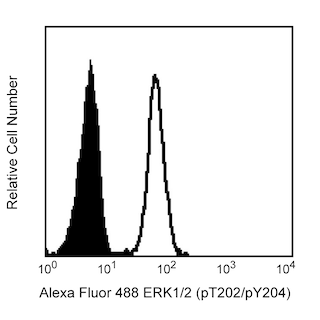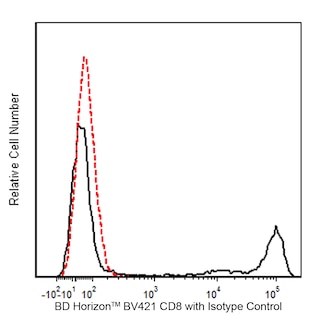Old Browser
Looks like you're visiting us from {countryName}.
Would you like to stay on the current country site or be switched to your country?


.png)

Two-color flow cytometric analysis of Granzyme K expression in Human peripheral blood lymphocytes. Human peripheral blood cells were treated (15 min; room temperature) with BD Phosflow™ Lyse/Fix Buffer (Cat. No. 558049) to lyse erythrocytes and fix leucocytes. The leucocytes were washed and then stained in BD Perm/Wash™ Buffer (Cat. No. 554723) with BD Horizon™ BV421 Mouse Anti-Human CD8 antibody (Cat. No. 562428) and with either BD Horizon™ RB780 Mouse IgG2a, κ Isotype Control (Cat. No. 568740; Left Plot) or BD Horizon™ RB780 Mouse Anti-Human Granzyme K antibody (Cat. No. 569225/569226; Right Plot). The pseudocolor density plot showing the correlated expression of Granzyme K (or Ig Isotype control staining) versus CD8 was derived from gated events with the forward and side light-scatter characteristics of intact lymphocytes. Flow cytometric analysis was performed using a BD LSRFortessa™ X-20 Cell Analyzer System.
.png)

BD Horizon™ RB780 Mouse Anti-Human Granzyme K
.png)
Regulatory Status Legend
Any use of products other than the permitted use without the express written authorization of Becton, Dickinson and Company is strictly prohibited.
Preparation And Storage
Recommended Assay Procedures
BD® CompBeads can be used as surrogates to assess fluorescence spillover (compensation). When fluorochrome conjugated antibodies are bound to BD® CompBeads, they have spectral properties very similar to cells. However, for some fluorochromes there can be small differences in spectral emissions compared to cells, resulting in spillover values that differ when compared to biological controls. It is strongly recommended that when using a reagent for the first time, users compare the spillover on cells and BD® CompBeads to ensure that BD® CompBeads are appropriate for your specific cellular application.
Product Notices
- When using high concentrations of antibody, background binding of this dye to erythroid fragments produced by ammonium chloride-based lysis, such as with BD Pharm Lyse™ Lysing Buffer (Cat. No. 555899), has been observed when the antibody conjugate was present during the lysis procedure. This may cause nonspecific staining of target cells, such as leukocytes, which have bound the resulting erythroid fragments. This background can be mitigated by any of the following: titrating the antibody conjugate to a lower concentration, fixing samples with formaldehyde, or removing erythrocytes before staining (eg, gradient centrifugation or pre-lysis with wash). This background has not been observed when cells were lysed with BD FACS™ Lysing Solution (Cat. No. 349202) after staining.
- Please refer to www.bdbiosciences.com/us/s/resources for technical protocols.
- Please observe the following precautions: Absorption of visible light can significantly alter the energy transfer occurring in any tandem fluorochrome conjugate; therefore, we recommend that special precautions be taken (such as wrapping vials, tubes, or racks in aluminum foil) to prevent exposure of conjugated reagents, including cells stained with those reagents, to room illumination.
- Caution: Sodium azide yields highly toxic hydrazoic acid under acidic conditions. Dilute azide compounds in running water before discarding to avoid accumulation of potentially explosive deposits in plumbing.
- This reagent has been pre-diluted for use at the recommended Volume per Test. We typically use 1 × 10^6 cells in a 100-µl experimental sample (a test).
- For fluorochrome spectra and suitable instrument settings, please refer to our Multicolor Flow Cytometry web page at www.bdbiosciences.com/colors.
- An isotype control should be used at the same concentration as the antibody of interest.
- Human donor specific background has been observed in relation to the presence of anti-polyethylene glycol (PEG) antibodies, developed as a result of certain vaccines containing PEG, including some COVID-19 vaccines. We recommend use of BD Horizon Brilliant™ Stain Buffer in your experiments to help mitigate potential background. For more information visit https://www.bdbiosciences.com/en-us/support/product-notices.
- Please refer to http://regdocs.bd.com to access safety data sheets (SDS).
- Cy is a trademark of Global Life Sciences Solutions Germany GmbH or an affiliate doing business as Cytiva.
- For U.S. patents that may apply, see bd.com/patents.
Companion Products


.png?imwidth=320)



The G3H69 monoclonal antibody specifically recognizes Granzyme K which is also known as GRAK, Granzyme-3, Fragmentin-3, Tryptase II (TRYP2), or NK-tryptase-2 (NK-Tryp-2). This granule-associated enzyme is a serine protease that cleaves peptides after the basic residues lysine and arginine. Granzyme K is encoded by GZMK (granzyme K) that belongs to the Granzyme subfamily (Granzymes A, B, H, K, M) within the peptidase S1 family. Granzyme K is expressed in the granules of CD56-bright natural killer (NK) cells, NKT cells, γδ T cells, and cytotoxic CD4+ T cells and CD8+ T cells that can kill pathogen-infected or tumor cells. Granzyme K can activate the SET complex enabling DNase NM23-H1 to make single-stranded nicks in chromosomal DNA which ultimately contribute to target cell death. Granzyme K can also act on Bid and p53 to activate certain cell death pathways. Elevated levels of Granzyme K have been observed in the blood and bodily fluids from individuals under certain infectious or inflammatory conditions.

Development References (6)
-
Bade B, Boettcher HE, Lohrmann J, et al. Differential expression of the granzymes A, K and M and perforin in human peripheral blood lymphocytes.. Int Immunol. 2005; 17(11):1419-28. (Biology). View Reference
-
Baracho GV, Kara N, Rigaud S, Lo E, Widmann SJ, Tyznik AJ. Functional phenotyping of circulating human cytotoxic T cells and NK cells using a 16-color flow cytometry panel.. STAR Protoc. 2022; 3(1):101069. (Clone-specific: Cytotoxicity, Functional assay, Intracellular Staining/Flow Cytometry). View Reference
-
Hameed A, Lowrey DM, Lichtenheld M, Podack ER. Characterization of three serine esterases isolated from human IL-2 activated killer cells. J Immunol. 1988; 141:3142-3147. (Biology). View Reference
-
Inagaki H, Hirata Y, Shimizu T, Kobayashi M, Li Q, Kawada T. Expression of granzyme 3 protein in human peripheral blood lymphocytes analyzed by flow cytometry (PP-108-30). Int Immunol (Abstract). 2010; 22:172. (Immunogen: Intracellular Staining/Flow Cytometry).
-
Lieberman J. The ABCs of granule-mediated cytotoxicity: new weapons in the arsenal.. Nat Rev Immunol. 2003; 3(5):361-70. (Biology). View Reference
-
Wilharm E, Parry MA, Friebel R, et al. Generation of catalytically active granzyme K from Escherichia coli inclusion bodies and identification of efficient granzyme K inhibitors in human plasma. J Biol Chem. 1999; 274:27331-27337. (Biology). View Reference
Please refer to Support Documents for Quality Certificates
Global - Refer to manufacturer's instructions for use and related User Manuals and Technical data sheets before using this products as described
Comparisons, where applicable, are made against older BD Technology, manual methods or are general performance claims. Comparisons are not made against non-BD technologies, unless otherwise noted.
For Research Use Only. Not for use in diagnostic or therapeutic procedures.
Refer to manufacturer's instructions for use and related User Manuals and Technical Data Sheets before using this product as described.
Comparisons, where applicable, are made against older BD technology, manual methods or are general performance claims. Comparisons are not made against non-BD technologies, unless otherwise noted.